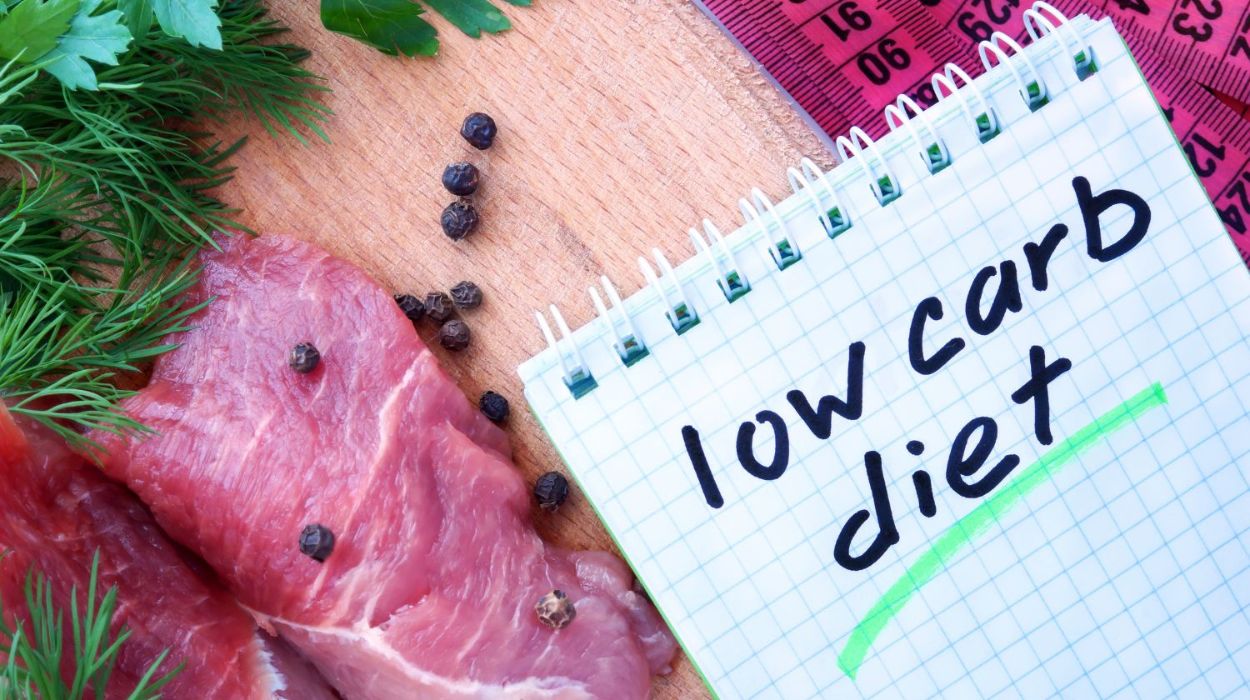 Expert's opinion
Expert's opinion
Expert's opinion
The article is a subjective view on this topic written by writers specializing in medical writing.
It may reflect on a personal journey surrounding struggles with an illness or medical condition, involve product comparisons, diet considerations, or other health-related opinions.
Although the view is entirely that of the writer, it is based on academic experiences and scientific research they have conducted; it is fact-checked by a team of degreed medical experts, and validated by sources attached to the article.
The numbers in parenthesis (1,2,3) will take you to clickable links to related scientific papers.
Intermittent Fasting On A Low-Carb Diet: How It Works?

Are you seeking effective methods to enhance your health and achieve weight loss? Here’s an eye-opening fact: Did you know that only 1-3% of individuals[1] actually lose weight and sustainably maintain that loss? This is because many conventional diets fall short in delivering long-term results and fail to address existing issues. Well, we have the solution!
In this article, we will introduce you to two powerful strategies gaining traction in the health and wellness community: Intermittent Fasting and Low Carb. These approaches offer a promising solution to transform your body, boost energy levels, and achieve sustainable weight loss.
Neglecting healthy eating habits and effective weight management can have detrimental effects, from wasting money on fad diets to experiencing low energy and increased health risks. To help navigate your journey, we will explore their benefits, and implementation tips, and guide you on this transformative experience toward a healthier, happier you.
Is Intermittent Fasting and a Low-Carb Diet for Everyone?
No, it is not. Before embracing intermittent fasting or a low-carb diet, it is crucial to consider individual factors. Intermittent fasting in simple terms involves cycling between fasting and eating. It is a great way to lose weight and increase insulin sensitivity. However, it may not suit those who are pregnant, and people with diabetes or eating disorders.
Likewise, low-carb diets restrict carb intake, promoting weight loss and improved heart health. But they may not be ideal for athletes or those with high energy needs. This is just another reason to always consult with a healthcare professional to evaluate your specific needs, health status, and goals before taking any action. Now, if you are considering incorporating intermittent fasting into your lifestyle and you are also an active individual, you may wonder about the compatibility of intermittent fasting and working out. There is good news, and it is that intermittent fasting can be combined with regular exercise to achieve positive results.
What Is Low-Carb Intermittent Fasting?
From merely looking at the name, this Is an eating pattern that involves “low-carb diets” and “intermittent fasting[2]“. It is interchanging between periods of fasting, which is summed up as calorie restriction, and taking meals that are specifically low in carbohydrates within a specific period to speed up weight loss.
To properly understand the concept, it is necessary to define the terms involved.
Fasting is a voluntary act when people skip eating for spiritual or health enhancing objectives, while starving means the involuntary lack of food for a lengthy time, which can lead to significant health difficulties and, in extreme cases, death. However, fasting is not for everyone and reasons for this include:
- Medical conditions
- Use of medication
- Nutritional requirement
- Malnourishment
- Individual differences
One example of low-carb intermittent fasting is combining fasting cycles with a ketogenic diet, also known as the Keto diet. The restriction of carbohydrates and the prolonged fasting periods work together to enhance the metabolic state of ketosis and promote greater fat utilization.
Intermittent Fasting Vs Low-Carb Diets

To optimize your health goals with dieting methods, it is essential to know the similarities and distinctions between intermittent fasting and low-carb diets.
Similarities:
- Both intermittent fasting and a low-carb diet can promote weight loss.
- They can improve insulin sensitivity[3].
- Intermittent fasting and a low-carb diet may increase fat burning and support a state of ketosis.
- They can help regulate blood sugar levels and improve overall metabolism[4].
Differences:
- Intermittent fasting focuses on when you eat, while a low-carb diet focuses on what you eat.
- Intermittent fasting involves cycles of fasting and eating windows, while a low-carb diet restricts carbohydrate intake.
- Intermittent fasting can be flexible in terms of food choices, while a low-carb diet specifically limits carbohydrate-rich foods.
- Intermittent fasting may have different fasting protocols, such as 16/8 or alternate-day fasting, while a low-carb diet does not have specific time restrictions.
- Intermittent fasting may require adjusting meal timing, while a low-carb diet requires careful carbohydrate management.
Benefits Of Doing Low Carb While Intermittent Fasting

Do you want to maintain optimal health and keep your weight under control? A keto intermittent fasting provides various benefits. Here’s what you need to know:
Burn Body Fat
Low-carb diets encourage the body to tap into stored excess fat supplies as fuel reserves, instead of relying solely on carbohydrate stores, resulting in a more efficient way to burn fat.
When you combine intermittent fasting (not eating any energy-containing foods) with a low-carb diet, your body shifts from using sugars as its main energy source, to breaking down fat for energy. This process is called ketosis[5].
Improved Insulin Sensitivity
Both practices have a positive impact on insulin sensitivity status when adequately adhered to.
Including intermittent fasting and implementing them into your daily routine can help control your blood sugar levels and prevent sudden increases that can stress your pancreas. This is especially important if you have insulin resistance or type 2 diabetes, as it can have long-term harmful effects on your health.
Faster Weight Loss
The combination also provides better chances of reaching a high-calorie deficit along declining eating window frames, resulting in optimal weight and fat loss[6]. Besides following a nutritious low-carb eating pattern, using the best intermittent fasting app can enhance your fasting experience and help you stay on track with your goals.
Risks And Side Effects
While low-carb intermittent fasting can offer several benefits, it is essential to be aware of potential risks and intermittent fasting side effects. Here are some considerations:
- Nutrient deficiencies
- Initial side effects (“keto flu”)
- Metabolic changes
- Electrolyte imbalances
- Disordered eating patterns
- Potential for muscle loss
- Individual variability
Considering the potential risks and side effects of low-carb intermittent fasting, it is important to approach this dietary plan with caution and awareness.
What Foods You Can Consume When Doing Low Carb During Fasting?

During the low-carb intermittent fasting process, you can consume a variety of nutrient-rich foods that are low in carbohydrates and high in protein. Here are some examples of foods you can include in your diet:
- Water
- Fish and seafood (salmon, sardines)
- Berries (Strawberries, blueberries, raspberries, blackberries)
- Avocado
- Cruciferous vegetables (leafy greens, broccoli, cauliflower, zucchini)
- Beans and legumes
- Supplements (low carb protein powder)
- Eggs
- Nuts (Almonds, Walnuts)
- Whole grains
Individual needs and preferences may vary. It is important to customize your low-carb intermittent fasting diet to suit your specific requirements.
Conclusion
Low-carb intermittent fasting can be a powerful approach to losing weight and promoting overall health. The combination of restricting carbohydrate intake and incorporating periods of fasting can create a synergistic effect, optimizing fat burning and metabolic efficiency. It is however crucial to prioritize safety and individual needs when embarking on this journey.
While low-carb intermittent fasting is safe and effective for many individuals, certain groups should exercise caution. Pregnant women, individuals with existing health conditions, and those with a history of eating disorders should stay away from fasting and consult with healthcare professionals before making any significant dietary changes.
Remember, maintaining a balanced approach and listening to your body signals are key. It is important to make sustainable lifestyle choices that you can maintain in the long run, promoting not only weight loss but also a healthy and enjoyable life.
Frequently Asked Questions
It is switching between periods of fasting and taking meals that are specifically low in carbohydrates within a specific time period.
If you have high blood sugar or too much insulin in your system, intermittent fasting may help. This might be the case after a period of not sticking to a low-carb diet, such as around the holidays or for a week or two afterward.
If you’ve been fasting for a short time, it is important to strive to maintain the metabolic gains you’ve made once you break your fast. This involves breaking your fast with low glycemic items such as cooked vegetables, berries, or poultry/fish and avoiding processed foods and sugar.
Although some people experience dizziness or low blood sugar/blood pressure when exercising while fasting, others have no such issues. The first time you work out, it is best to ease into it and pay close attention to how your body responds.
Make sure you get enough high-quality calories throughout your feeding window no matter what form of fasting you practice. Consume plenty of protein, healthy fats, and fiber-rich carbohydrates.
It helps in weight loss, improved insulin sensitivity, also to burns fat faster. It also helps in supporting cognitive functions, breaking food addiction, and reducing inflammation.
While safe for many pregnant and lactating women, individuals with medical conditions and those with eating disorders should not fast.
Low-carb intermittent fasting aids in weight loss by creating a calorie deficit and promoting fat burning.
+ 6 sources
Health Canal avoids using tertiary references. We have strict sourcing guidelines and rely on peer-reviewed studies, academic researches from medical associations and institutions. To ensure the accuracy of articles in Health Canal, you can read more about the editorial process here
- US), M. (2023). Weight-Loss and Maintenance Strategies. [online] Nih.gov. Available at: https://www.ncbi.nlm.nih.gov/books/NBK221839/.
- Harvard Health. (2020). Time to try intermittent fasting? – Harvard Health. [online] Available at: https://www.health.harvard.edu/heart-health/time-to-try-intermittent-fasting.
- Aljadah, M. and Bakke, J. (2021). Intermittent fasting: is there a role in the treatment of diabetes? A review of the literature and guide for primary care physicians. [online] 7(1). doi:https://doi.org/10.1186/s40842-020-00116-1.
- Izzah Vasim, Chaudry Nasir Majeed and DeBoer, M.D. (2022). Intermittent Fasting and Metabolic Health. [online] 14(3), pp.631–631. doi:https://doi.org/10.3390/nu14030631.
- Clinic, C. (2022). Ketosis: Definition, Benefits & Side Effects – Cleveland Clinic. [online] Cleveland Clinic. Available at: https://my.clevelandclinic.org/health/articles/24003-ketosis#:~:text=Ketosis%20is%20a%20metabolic%20state,%E2%80%9Cketo%E2%80%9D%20breath%20and%20constipation.
- Welton, S., Minty, R., O’Driscoll, T., Willms, H., Poirier, D., Madden, S. and Kelly, L. (2020). Intermittent fasting and weight loss: Systematic review. Canadian family physician Medecin de famille canadien, [online] 66(2), pp.117–125. Available at: https://www.ncbi.nlm.nih.gov/pmc/articles/PMC7021351/.



